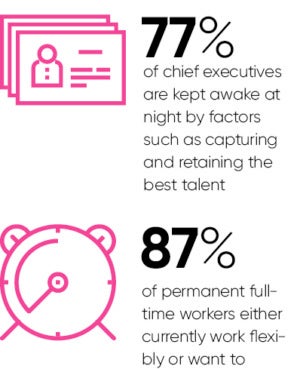The fourth industrial revolution, industry 4.0 – call it what you will, the workplace and all those within it are in the midst of the biggest revolution since the industrial age.
An emerging consequence of this is demand for remote and flexible working, and the hours and the type of work required, peaking dramatically over the last few years. In the UK alone the number of home-workers has gone up by nearly a quarter of a million in the last decade and 87 per cent of permanent full-time workers either currently work flexibly or want to. Few millennials or generation 2020 see their career comprising a job for life.
These are factors visionary organisations recognise as too important to ignore and particularly in a business world where competition on price is itself now competing more than ever with profit margin pressures alongside the need to capture and retain the best talent. Factors that are keeping 77 per cent of chief executives awake at night.
 An additional factor senior managers are wrestling with is the need to balance these emerging resource demands against an increasing need to keep delivering the best possible customer experience and outcomes. More often than not, this must be delivered on a 24/7 basis and across an increasing number of channels, each of which demands increased consumer expectation in terms of time to decision and response.
An additional factor senior managers are wrestling with is the need to balance these emerging resource demands against an increasing need to keep delivering the best possible customer experience and outcomes. More often than not, this must be delivered on a 24/7 basis and across an increasing number of channels, each of which demands increased consumer expectation in terms of time to decision and response.
The always-on consumer, with a wealth of communication channels at their fingertips, is less forgiving and more demanding than their analogue predecessors and certainly more prepared to jump to social media to communicate to the world where outcomes are not as desired. In parallel, the same cohort is ready to socialise a good experience, albeit perhaps not with the same vigour if they receive a positive service outcome.
Statistics show that businesses that successfully meet these demands and provide a positive customer experience grow revenue faster than customer experience laggards, drive higher brand preference and, in doing so, improve retention levels and possibly also influence margin.
So how do organisations deliver required outcomes while meeting their employees’ needs for remote and flexible working? These two objectives need not be mutually exclusive, provided businesses optimise operational processes, promote customer-centric behaviours and culture, and also invest in the right technology to utilise and focus employee effort to meet customer demands.
Remote workers and employees working flexible hours are now able to play an increased role in servicing the always-on customer and contributing to the overall customer experience.
An important first step is for businesses to evolve from traditional command-and-control tactics, and embrace a more collaborative way of working, centred on the end-to-end customer interaction, ensuring the relevant skills and capabilities reside within an empowered workforce.
A second key step is to invest in the ability to forecast accurately and utilise these skills and capabilities to allocate work to the workforce efficiently and effectively, regardless of physical location or time zone. This must coincide with the ability to monitor resource activity and utilisation fully, and importantly be able to evidence quality and compliance. Having this complete view of all capability within and across customer operations is no longer an operational luxury.
Managers need a comprehensive view of the workloads and subsequent performance of their teams. They need intraday and predictive analytics, alerts and performance notifications embedded within solutions that let them know where both latency and surplus resource exist before things go wrong. And they need this detail in real time.
Processes span what have traditionally been labelled front and back office. Providing real-time insight into these operations and forecasting of the workload should allow processes to be better optimised so resources can be allocated to deliver on the customer outcome, blending front and back office to service the customer best. Research from McKinsey suggests that companies doing this are achieving up to 50 per cent increases in efficiency in some back-office functions.
The combined solutions of eg and Verint empower employees and enhance workforce effectiveness by capitalising on the capability and availability of staff, while enabling a more engaged and empowered approach to customer service delivery
This is precisely why Verint has invested in enterprise workforce software by acquiring eg solutions, a pioneering back-office workforce optimisation software group. With solutions from Verint and eg, businesses can benefit from managing work, people and processes across the enterprise regardless of location, time zone or device.
The combined solutions of eg and Verint empower employees and enhance workforce effectiveness by capitalising on the capability and availability of staff, while enabling a more engaged and empowered approach to customer service delivery.
In a world where both customers and talent have high expectations, and their engagement and satisfaction defines a sustainable competitive advantage, successful organisations are those that will make the latter work to support the former. By investing in the right infrastructure, processes and culture to build a more collaborative and flexible workplace, businesses can strike the right balance to cement their place as a market leader.
For more information please visit www.verint.com

